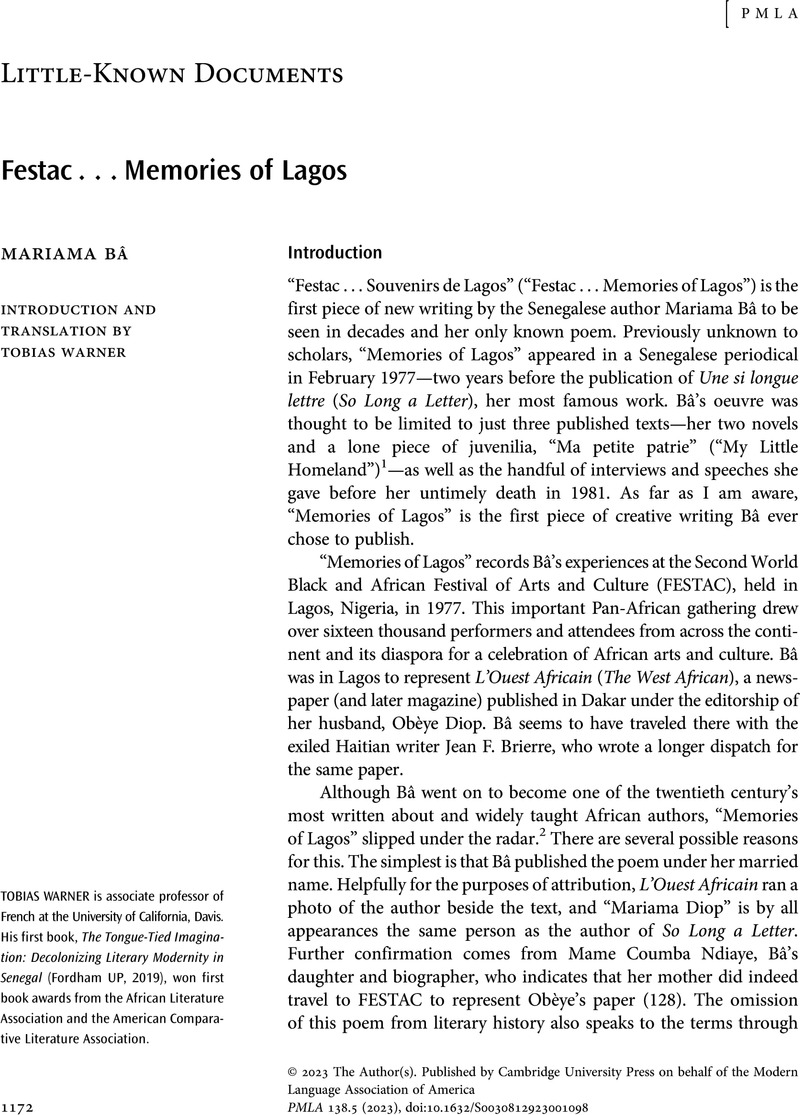No CrossRef data available.
Article contents
Festac . . . Memories of Lagos
Published online by Cambridge University Press: 02 January 2024
Abstract
An abstract is not available for this content so a preview has been provided. Please use the Get access link above for information on how to access this content.

Information
- Type
- Little-Known Documents
- Information
- Copyright
- Copyright © 2023 The Author(s). Published by Cambridge University Press on behalf of the Modern Language Association of America
References
Works Cited
Andrade, Susan Z. The Nation Writ Small: African Fictions and Feminisms, 1958–1988. Duke UP, 2011.Google Scholar
Apter, Andrew. The Pan-African Nation: Oil and the Spectacle of Culture in Nigeria. U of Chicago P, 2008.Google Scholar
Bâ, Mariama [published as Mariama Diop]. “Festac . . . Souvenirs de Lagos.” L'Ouest Africain, Feb. 1977, p. 32.Google Scholar
Bâ, Mariama [published as Mariama Diop]. Une si longue lettre. Le Serpent à Plumes, 2001.Google Scholar
Colloquium Proceedings. Federal Military Government of Nigeria, 1977. Colloquium on Black Civilization and Education.Google Scholar
Diop, David Mandessi. “Appel.” Coups de pilon: Poèmes, Présence africaine, 1961, p. 52.Google Scholar
Edjabe, Ntone, and Adesokan, Akinwumi. FESTAC ’77: Second World Black and African Festival of Arts and Culture. Chimurenga, 2019.Google Scholar
Jaji, Tsitsi Ella. Africa in Stereo: Modernism, Music, and Pan-African Solidarity. Oxford UP, 2014.CrossRefGoogle Scholar
Joseph-Gabriel, Annette K. Reimagining Liberation: How Black Women Transformed Citizenship in the French Empire. U of Illinois P, 2019.Google Scholar
Ndiaye, Mame Coumba. Mariama Bâ; ou, Les allées d'un destin. Nouvelles Éditions africaines du Sénégal, 2007.Google Scholar
Riesz, János, and Bjornson, Richard. “Mariama Bâ's ‘Une Si Longue Lettre’: An Erziehungsroman.” Research in African Literatures, vol. 22, no. 1, spring 1991, pp. 27–42.Google Scholar
Saint, Lily, and Shringarpure, Bhakti. “African Literature Is a Country.” Africa Is a Country, 8 Aug. 2020, africasacountry.com/2020/08/african-literature-is-a-country.Google Scholar

